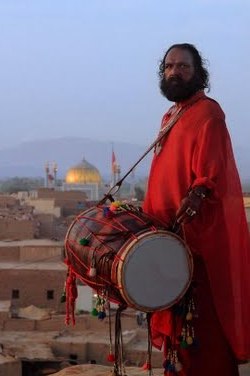 “Mast O Mast Qalandar Teri Haan Mein Teri Haan”, Abida Parveen’s deep drone filled the air as special train to Sehwan crawled into Railway station like a lazy dragon. Motley crowd of devotees, malangs and dervishes hung from compartments, windows and train top. Loud chants “Dam Mast Qalandarâ€, “Ali Maula“ and “Bolo Lal Qalandar“ rocked the platform.
“Mast O Mast Qalandar Teri Haan Mein Teri Haan”, Abida Parveen’s deep drone filled the air as special train to Sehwan crawled into Railway station like a lazy dragon. Motley crowd of devotees, malangs and dervishes hung from compartments, windows and train top. Loud chants “Dam Mast Qalandarâ€, “Ali Maula“ and “Bolo Lal Qalandar“ rocked the platform.
People waved red flags and ran along the train. Thousands thronged dusty streets of sacred city of Sehwan to attend the annual Urs of Hazrat Lal Shahbaz Qalandar (currently underway). Cramped on a berth, I witnessed this unprecedented gathering of pilgrims from the compartment window. Tears of devotion faded my vision. Scenes blurred but I could hear this happening all around me in grand glory.
The medley of performances – from Abida Parveen, Junoon, Nur Jahan, and Nusrat Fateh Ali Khan – above demonstrate the special place that Lal Shahbaz has in our spiritual heritage.
Lal Shahbaz Qalandar was born as Syed Shah Hussein, later named as Usman by his father. His date of birth is shrouded in mystery but careful speculation reveals that it was 1187 AD, although some biographers claim it to be 1177 AD. He was born into an Uzbek tribe who was direct decedents of Imam Jafar Sadiq and belonged to Ismaili faith.
Hazrat Usman Marvandi had a free spirit. He wandered far and wide in his quest for Divine unity. People called him “Shahbaz†[Falcon] due to his free divine spirit and adventurous quest. He joined Qalandariya order at the age of 20. Qalandariya is a unique branch of Sufism which is attained through unprecedented spiritual training and self negation.
He met Sharf ud Din Boo Ali Qalandar who advised him to travel to Sindh and stay there. Sehwan, in those days was considered a strategic point from where areas around upper and lower Indus could be easily accessed. Besides, it always remained a significant city in the history of Sindh. As advised by Hazrat Boo Ali Qalandar, Lal Shahbaz decided to settle in Sehwan and lived there for six years till his death.
18th Shaban marks three day celebrations of Lal Shahbaz Qalandar’s annual Urs. Devotees from all over Pakistan arrive in Sehwan. Narrow streets and mud and brick houses are flooded with zestful tourists and pilgrims. Sehwan suddenly becomes nosiy and dirty. Some five hundred thousand pilgrims visit Shrine of Lal Shahbaz Qalandar from 18th to 20th Shaban every year.
People, people everywhere! Dancing, mourning, chanting, shouting and crying. Every house in Sehwan is on rent. Streets clog with sewerage water. Nobody sleeps. A party carrying embroided chaddars to Lal Shahbaz’s shrine. Another group mourning and wailing. A few streets ahead some devoted followers carrying candles and Mehndi as offering, clad in colorful attire, dancing in unbound joy and ecstatic pleasure. A group of women carrying lamps and scented wood. But all have to line up and wait outside the shrine which is engulfed by a sea of mourner’s processions. A deep thud of mourning hands strikes bare chests in every nock and corner of dimly lit streets around the shrine.
Zanjir zani and matam continues inside the vast compound. Blood oozes and spills carelessly on the marble floor as sharp blades of angled knives mark deep cuts in flesh of matmi procession. Jubilation is taken over by gore. Shock and awe prevail. Most of the pilgrims are not prepared for this but the sight is gruesome. Wailing continues, matam and zanjir zani gather pace. Blood spills, people faint due to loss of blood and fatigue.
First aid camps are jam packed. One procession of mourners leaves and another arrives. Saga continues recklessly for three days and three nights. A few streets away from this sight, Sehwan celebrates in more moderate manner. Musicians and artists from various cities gather outside a dusty pavilion near Kafi Lal Das [a devotee of Lal Shahbaz Qalendar who initiated lighting up of Chiragh at the shrine and thus became known as Saien Lal Das Chiraghi Waley].
Papu Saien Dholia with his sungat arrives and the audience is spellbound. No artist of ordinary merit dares walk in that narrow and congested street of Kafi Lal Das.
I sit on a high point outside Sehwan and watch the city stretched before my eyes. Rising sun bathes the shrine in pure and pious light.
Red flags on rooftops flutter as wind blows across the dusty panorama. Golden doom of awesome shrine stands majestically amid tiny houses and narrow streets of Sehwan. A sacred hush prevails.
I experience a moment of frayed sanity and wait for something to change inside. Nothing changes or maybe I can not judge it at the moment. I trace my way back to the city with tired steps of an abandoned sage. Sound of mourning becomes louder and louder.
Umair Ghani is a photographer and writer. All photographs except one are by the author himself. Special thanks to legendary Dhol artiste Papu Saien for his early morning photos outside Sehwan City. As of August 11, 2009, 757th urs of Lal Shahbaz Qalandar is going on in Sehwan.
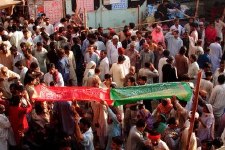
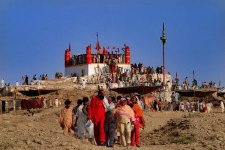
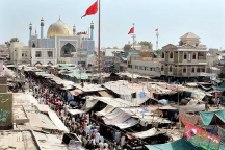

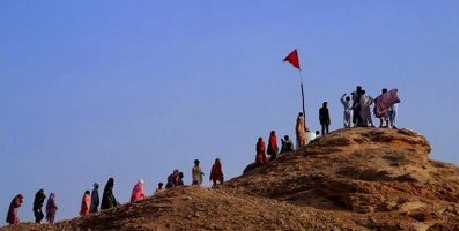



















































beautiful artical i m planning to visit sehwan shareef on my trip to visit pakistan this year. Lal Shehbaz Qalander was a real wali ullah we shud all respect him and i dont understand why people always spread there negative thinking everywhere on net if u dont belive in such things then please stay out of it. people are now fedup with ur lecturebazi of telling everyone what the real islam is. let everyone practice their religion with freedom.
What a stupid piece of bullshit. I am Alhamdulilla a Shia Muslim but I don’t believe in such ridiculous atrocities on the image of our beloved Islamic faith. That guy you people are praising is laying dead for hundreds of years. He can’t provide you any benefit or harm. This is totally shirk and I feel very sorry for the shameful acts and beliefs of our people. He’s a Sayyed doesn’t mean he’s like anyone from Ahl-beit(AS) nauzubilla. A fatiha on his shrine is the only best thing we can do instead of dancing or mourning and regarding him as someone divine and godly. Allah hum subb ko in shirk waley kamo’n sey duur rehney toufeed ataa farmaye…. AMEEN
the shamful acts which are performed by the visitors and pilgrims over here made me surprised that how the ignorant people bring infamy to islam and holy people like shahbaz qalandar. the govt and concerned authorities must take notice and punish all those who commit such heanous acts.
Good article!
I like to enjoy original version of “Dam Mast Qalandar” any time. Lal Shahbaz Qalandar a great person, could motivate Islam religion to the right path. We should proud of him.
With this all bad name to Islam, we need more people like Shahbaz Qalandar, who can guide people to the true path of Islam.
Today Islam had ended up being compulsive, corrupt, non-tolerant, violent. If you look at the life of Muhammad, you will see none of this characteristics. Unlike the time of Muhammad when Islam meant peace, in today’s life both shias and sunnis have made Islam a religion of terrorism and distraction. Every day we hear Muslims killing Muslims.
This Islam has been politicized and changed. Islam was religion of peace and prosperity and we need people like Shahbaz Qalandar who can bring back the lost glory of Islam.